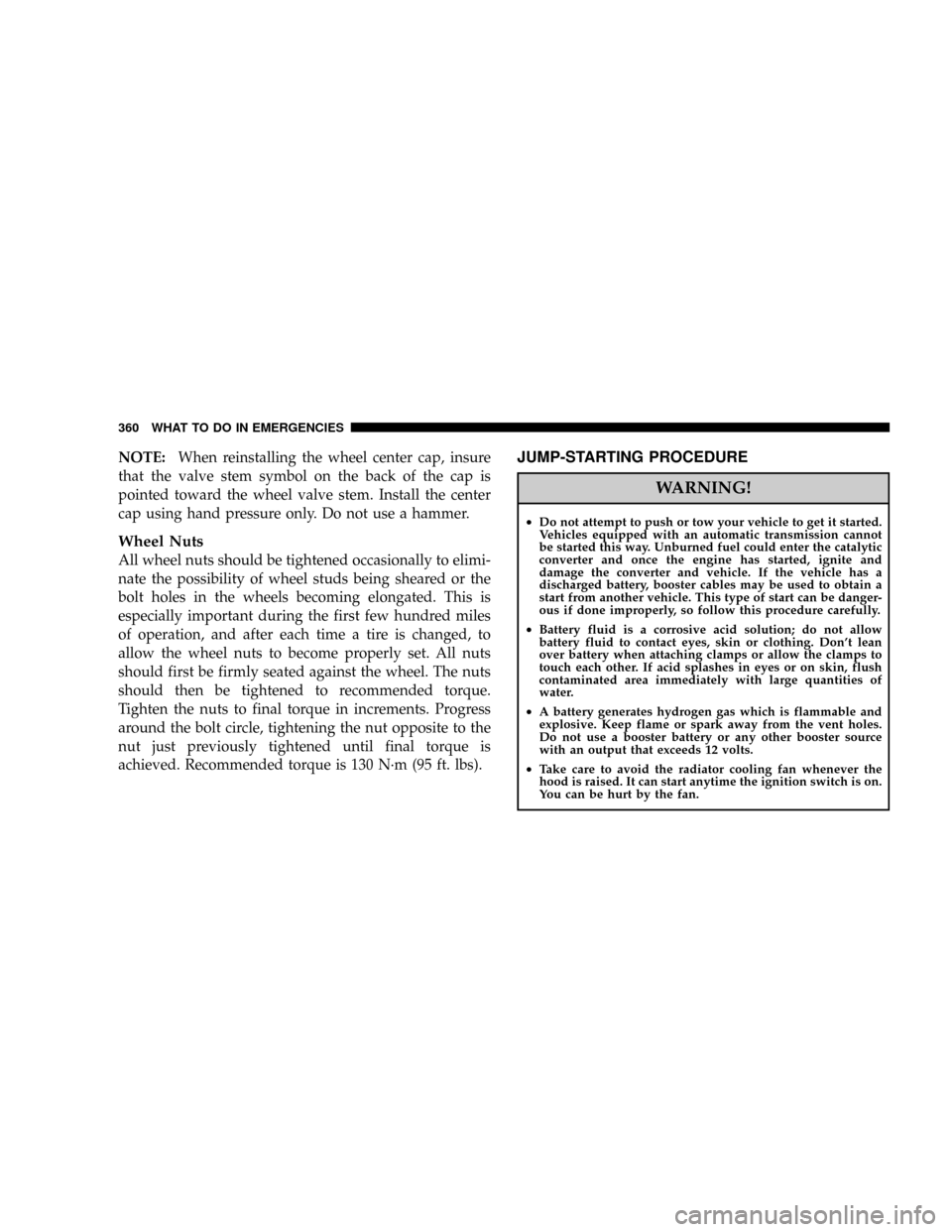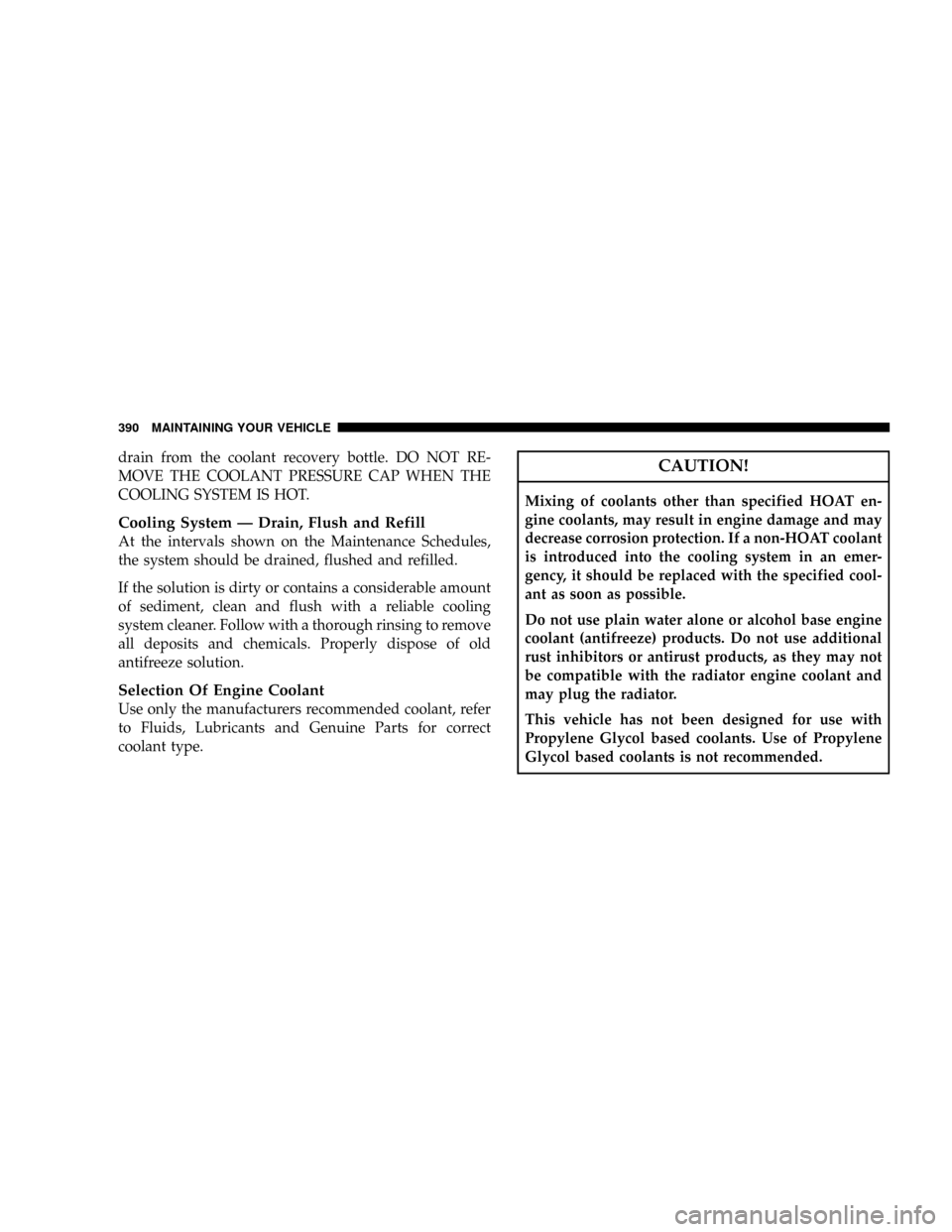2008 CHRYSLER PACIFICA radiator cap
[x] Cancel search: radiator capPage 360 of 457

NOTE:When reinstalling the wheel center cap, insure
that the valve stem symbol on the back of the cap is
pointed toward the wheel valve stem. Install the center
cap using hand pressure only. Do not use a hammer.
Wheel Nuts
All wheel nuts should be tightened occasionally to elimi-
nate the possibility of wheel studs being sheared or the
bolt holes in the wheels becoming elongated. This is
especially important during the first few hundred miles
of operation, and after each time a tire is changed, to
allow the wheel nuts to become properly set. All nuts
should first be firmly seated against the wheel. The nuts
should then be tightened to recommended torque.
Tighten the nuts to final torque in increments. Progress
around the bolt circle, tightening the nut opposite to the
nut just previously tightened until final torque is
achieved. Recommended torque is 130 N´m (95 ft. lbs).
JUMP-STARTING PROCEDURE
WARNING!
²Do not attempt to push or tow your vehicle to get it started.
Vehicles equipped with an automatic transmission cannot
be started this way. Unburned fuel could enter the catalytic
converter and once the engine has started, ignite and
damage the converter and vehicle. If the vehicle has a
discharged battery, booster cables may be used to obtain a
start from another vehicle. This type of start can be danger-
ous if done improperly, so follow this procedure carefully.
²Battery fluid is a corrosive acid solution; do not allow
battery fluid to contact eyes, skin or clothing. Don't lean
over battery when attaching clamps or allow the clamps to
touch each other. If acid splashes in eyes or on skin, flush
contaminated area immediately with large quantities of
water.
²A battery generates hydrogen gas which is flammable and
explosive. Keep flame or spark away from the vent holes.
Do not use a booster battery or any other booster source
with an output that exceeds 12 volts.
²Take care to avoid the radiator cooling fan whenever the
hood is raised. It can start anytime the ignition switch is on.
You can be hurt by the fan.
360 WHAT TO DO IN EMERGENCIES
Page 389 of 457

Cooling System
WARNING!
²When working near the radiator cooling fan, dis-
connect the fan motor lead or turn the ignition
switch to the OFF position. The fan is temperature
controlled and can start at any time the ignition
switch is in the ON position.
²You or others can be badly burned by hot coolant
or steam from your radiator. If you see or hear
steam coming from under the hood, don't open the
hood until the radiator has had time to cool. Never
try to open a cooling system pressure cap when the
radiator is hot.
Engine Coolant Checks
Check the engine coolant (antifreeze) protection every 12
months (before the onset of freezing weather, where
applicable). If coolant is dirty or rusty in appearance, the
system should be drained, flushed and refilled with fresh
coolant. Check the front of the A/C condenser for any
accumulation of bugs, leaves, etc. If dirty, clean by gently
spraying water from a garden hose vertically down the
face of the condenser.
Check the coolant recovery bottle tubing for brittle rub-
ber, cracking, tears, cuts and tightness of the connection
at the bottle and radiator. Inspect the entire system for
leaks.
With the engine at normal operating temperature (but
not running), check the cooling system pressure cap for
proper vacuum sealing by draining a small amount of
coolant from the radiator drain cock. If the cap is sealing
properly, the engine coolant (antifreeze) will begin to
MAINTAINING YOUR VEHICLE 389
7
Page 390 of 457

drain from the coolant recovery bottle. DO NOT RE-
MOVE THE COOLANT PRESSURE CAP WHEN THE
COOLING SYSTEM IS HOT.
Cooling System Ð Drain, Flush and Refill
At the intervals shown on the Maintenance Schedules,
the system should be drained, flushed and refilled.
If the solution is dirty or contains a considerable amount
of sediment, clean and flush with a reliable cooling
system cleaner. Follow with a thorough rinsing to remove
all deposits and chemicals. Properly dispose of old
antifreeze solution.
Selection Of Engine Coolant
Use only the manufacturers recommended coolant, refer
to Fluids, Lubricants and Genuine Parts for correct
coolant type.
CAUTION!
Mixing of coolants other than specified HOAT en-
gine coolants, may result in engine damage and may
decrease corrosion protection. If a non-HOAT coolant
is introduced into the cooling system in an emer-
gency, it should be replaced with the specified cool-
ant as soon as possible.
Do not use plain water alone or alcohol base engine
coolant (antifreeze) products. Do not use additional
rust inhibitors or antirust products, as they may not
be compatible with the radiator engine coolant and
may plug the radiator.
This vehicle has not been designed for use with
Propylene Glycol based coolants. Use of Propylene
Glycol based coolants is not recommended.
390 MAINTAINING YOUR VEHICLE
Page 391 of 457

Adding Engine Coolant
Your vehicle has been built with an improved engine
coolant that allows extended maintenance intervals. This
coolant can be used up to 5 Years or 100,000 miles before
replacement. To prevent reducing this extended mainte-
nance period, it is important that you use the same
coolant throughout the life of your vehicle. Please review
these recommendations for using Hybrid Organic Addi-
tive Technology (HOAT) coolant.
When adding coolant, a minimum solution of 50% rec-
ommended Mopar Antifreeze/ Coolant 5 Year / 100,000
Mile Formula HOAT (Hybrid Organic Additive Technol-
ogy), or equivalent, in water should be used. Use higher
concentrations (not to exceed 70%) if temperatures below
234ÉF (237ÉC ) are anticipated.
Use only high purity water such as distilled or deionized
water when mixing the water/engine coolant solution.The use of lower quality water will reduce the amount of
corrosion protection in the engine cooling system.
Please note that it is the owner's responsibility to main-
tain the proper level of protection against freezing ac-
cording to the temperatures occurring in the area where
the vehicle is operated.
NOTE:Mixing coolant types will decrease the life of the
engine coolant and will require more frequent coolant
changes.
Cooling System Pressure Cap
The cap must be fully tightened to prevent loss of
coolant, and to insure that coolant will return to the
radiator from the coolant recovery bottle.
The cap should be inspected and cleaned if there is any
accumulation of foreign material on the sealing surfaces.
MAINTAINING YOUR VEHICLE 391
7
Page 392 of 457

WARNING!
²The warning words ªDO NOT OPEN HOTº on
the cooling system pressure cap are a safety pre-
caution. Never add coolant when the engine is
overheated. Do not loosen or remove the cap to
cool an overheated engine. Heat causes pressure to
build up in the cooling system. To prevent scald-
ing or injury, do not remove the pressure cap while
the system is hot or under pressure.
²Do not use a pressure cap other than the one
specified for your vehicle. Personal injury or en-
gine damage may result.
Disposal of Used Engine Coolant
Used ethylene glycol based engine coolant is a regulated
substance requiring proper disposal. Check with your
local authorities to determine the disposal rules for yourcommunity. To prevent ingestion by animals or children
do not store ethylene glycol based engine coolant in open
containers or allow it to remain in puddles on the
ground. If ingested by a child, contact a physician
immediately. Clean up any ground spills immediately.
Engine Coolant Level
The coolant bottle provides a quick visual method for
determining that the coolant level is adequate. With the
engine off and cold, the coolant level in the coolant
recovery bottle should be between the ranges indicated
on the bottle.
The radiator normally remains completely full, so there is
no need to remove the radiator cap unless checking for
coolant freeze point or replacing coolant. Advise your
service attendant of this. As long as the engine operating
temperature is satisfactory, the coolant bottle need only
be checked once a month.
392 MAINTAINING YOUR VEHICLE
Page 440 of 457

Caps, Filler
Fuel................................ 329
Oil (Engine).......................... 378
Radiator (Coolant Pressure)............... 391
Car Washes............................ 402
Carbon Monoxide Warning................. 328
Cargo Area Cover....................... 176
Cargo Compartment
Luggage Carrier....................... 178
Cargo Tie-Downs........................ 177
Catalytic Converter...................... 380
Caution, Exhaust Gas...................78,388
CD (Compact Disc) Changer..........218,228,232
CD (Compact Disc) Player......212,216,222,226,232
CD (Compact Disc) Player Maintenance........ 250
Cellular Phone........................89,250
Chains, Tire............................ 312
Changing A Flat Tire..................... 352
Chart, Tire Sizing........................ 296Check Engine Light (Malfunction Indicator
Light).............................193,373
Child Restraint........................67,69
Child Restraint Tether Anchors.............71,74
Child Safety Locks........................ 30
Child Seat.............................. 75
Clean Air Gasoline....................... 326
Cleaning
Wheels............................. 403
Climate Control......................... 250
Clock................................ 209
Compact Disc (CD) Maintenance............. 250
Compact Spare Tire...................... 307
Compass.............................. 207
Compass Calibration..................... 207
Compass Variance....................... 207
Computer, Trip/Travel.................... 208
Console.............................. 175
Console, Floor.......................... 175
440 INDEX
Page 441 of 457

Console, Overhead....................... 168
Contract, Service........................ 430
Coolant Pressure Cap (Radiator Cap).......... 391
Cooling System......................... 389
Adding Coolant (Antifreeze).............. 391
Coolant Capacity...................... 416
Coolant Level......................389,392
Disposal of Used Coolant................ 392
Drain, Flush, and Refill.................. 390
Inspection........................... 392
Points to Remember.................... 393
Pressure Cap......................... 391
Radiator Cap......................... 391
Selection of Coolant (Antifreeze)......390,416,417
Cruise Control (Speed Control).............. 144
Cruise Light........................... 193
Cup Holder.........................174,406
Customer Assistance..................... 428Data Recorder, Event...................... 65
Dealer Service.......................... 375
Defroster, Rear Window................... 269
Defroster, Windshield................79,256,265
Delay (Intermittent) Wipers................. 141
Diagnostic System, Onboard................ 372
Digital Video Disc (DVD) Player............. 232
Dimmer Switch, Headlight................. 139
Dipsticks
Automatic Transmission................. 399
Oil (Engine).......................... 376
Disabled Vehicle Towing................... 363
Disposal
Antifreeze (Engine Coolant)............... 392
Engine Oil........................... 379
Door Ajar Light......................... 197
Door Locks............................. 26
Door Locks, Automatic.................... 27
Door Opener, Garage..................... 146
INDEX 441
10
Page 450 of 457

Preparation for Jacking.................... 355
Pretensioners
Seat Belts............................. 47
Programmable Electronic Features.........147,203
Programming Transmitters (Remote Keyless
Entry)..............................24,147
Radial Ply Tires......................... 306
Radiator Cap (Coolant Pressure Cap).......390,391
Radio Broadcast Signals................... 210
Radio Operation........................ 250
Radio Remote Controls.................235,249
Radio, Satellite.......................... 245
Radio (Sound Systems).................212,222
Rear Camera........................... 166
Rear Liftgate............................ 34
Rear Park Sense System................... 160
Rear Seating Flexibility.................... 126
Rear Window Defroster................... 269Rear Window Features.................... 141
Rear Wiper/Washer...................... 141
Rearview Mirrors........................ 86
Reclining Front Seats..................... 120
Recorder, Event Data...................... 65
Recreational Towing...................348,365
Reminder, Seat Belt....................... 47
Remote Control......................... 235
Remote Keyless Entry (RKE)................. 20
Remote Sound System (Radio) Controls........ 249
Replacement Keys........................ 16
Replacement Parts....................... 375
Replacement Tires....................... 310
Reporting Safety Defects................... 431
Resetting Oil Change Indicator...........192,202
Restraint, Head......................... 117
Restraints, Child.......................67,75
Restraints, Infant......................... 68
Retractable Cargo Area Cover............... 176
450 INDEX